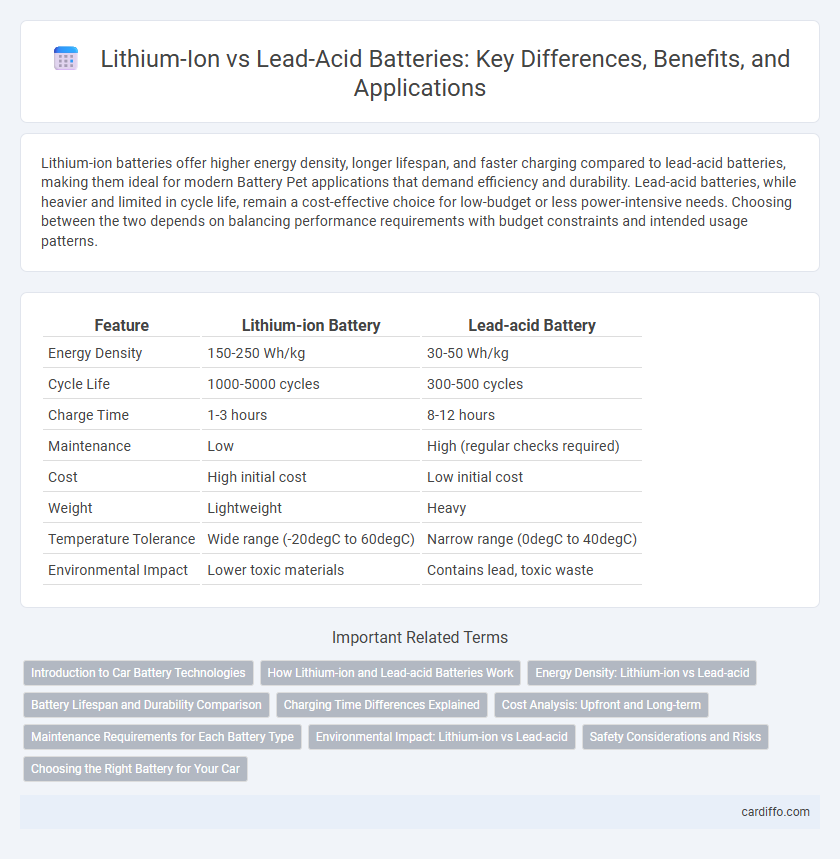Lithium-ion batteries offer higher energy density, longer lifespan, and faster charging compared to lead-acid batteries, making them ideal for modern Battery Pet applications that demand efficiency and durability. Lead-acid batteries, while heavier and limited in cycle life, remain a cost-effective choice for low-budget or less power-intensive needs. Choosing between the two depends on balancing performance requirements with budget constraints and intended usage patterns.
Table of Comparison
| Feature | Lithium-ion Battery | Lead-acid Battery |
|---|---|---|
| Energy Density | 150-250 Wh/kg | 30-50 Wh/kg |
| Cycle Life | 1000-5000 cycles | 300-500 cycles |
| Charge Time | 1-3 hours | 8-12 hours |
| Maintenance | Low | High (regular checks required) |
| Cost | High initial cost | Low initial cost |
| Weight | Lightweight | Heavy |
| Temperature Tolerance | Wide range (-20degC to 60degC) | Narrow range (0degC to 40degC) |
| Environmental Impact | Lower toxic materials | Contains lead, toxic waste |
Introduction to Car Battery Technologies
Lithium-ion and lead-acid batteries represent the primary technologies in car battery systems, with lithium-ion offering higher energy density and longer cycle life compared to the traditional lead-acid design. Lead-acid batteries remain widely used due to their lower cost and reliable performance in standard vehicle starting applications. Advances in lithium-ion technology are driving adoption in electric vehicles, where weight reduction and improved recharge efficiency are critical factors.
How Lithium-ion and Lead-acid Batteries Work
Lithium-ion batteries operate through the movement of lithium ions between the anode and cathode during charge and discharge cycles, enabling high energy density and longer lifespan. Lead-acid batteries function by converting chemical energy through the reaction between lead dioxide, sponge lead, and sulfuric acid, resulting in lower energy density but cost effectiveness. The electrochemical processes in lithium-ion batteries provide faster charging and lighter weight compared to the heavier, more maintenance-intensive lead-acid batteries.
Energy Density: Lithium-ion vs Lead-acid
Lithium-ion batteries exhibit significantly higher energy density, typically ranging from 150 to 250 Wh/kg, compared to lead-acid batteries, which generally offer 30 to 50 Wh/kg. This superior energy density enables lithium-ion batteries to store more energy in a smaller and lighter form factor, making them ideal for portable electronics and electric vehicles. Lead-acid batteries, although robust and cost-effective, are bulkier and heavier due to their lower energy density, limiting their use in applications requiring compact power sources.
Battery Lifespan and Durability Comparison
Lithium-ion batteries typically offer a longer lifespan, averaging 1,000 to 2,000 charge cycles, compared to lead-acid batteries, which usually last around 300 to 500 cycles. Durability-wise, lithium-ion cells are more resistant to deep discharge and temperature fluctuations, enhancing overall performance in varied conditions. Lead-acid batteries often experience sulfation and capacity loss over time, which reduces their longevity and efficiency.
Charging Time Differences Explained
Lithium-ion batteries offer significantly faster charging times compared to lead-acid batteries, often reaching full charge within 1 to 4 hours, while lead-acid batteries typically require 8 to 12 hours. This efficiency is due to lithium-ion's higher charge acceptance rates and advanced electrode materials, enabling rapid ion movement during charging. Faster charging reduces downtime in applications such as electric vehicles and renewable energy storage, enhancing overall performance and usability.
Cost Analysis: Upfront and Long-term
Lithium-ion batteries have a higher upfront cost, typically ranging from $500 to $700 per kWh, compared to lead-acid batteries costing around $100 to $200 per kWh. Despite the initial investment, lithium-ion batteries offer a longer lifespan of 8 to 15 years and greater cycle efficiency, reducing replacement frequency and maintenance costs over time. Lead-acid batteries generally last 3 to 5 years with lower energy density, leading to increased total cost of ownership due to frequent replacements and reduced performance.
Maintenance Requirements for Each Battery Type
Lithium-ion batteries require minimal maintenance, with no need for regular watering or equalization charges, making them ideal for applications demanding low upkeep. Lead-acid batteries demand frequent maintenance, including checking electrolyte levels, topping up distilled water, and performing equalization charges to prevent sulfation and extend battery life. Proper maintenance of lead-acid batteries is critical to avoid capacity loss and ensure reliable performance over time.
Environmental Impact: Lithium-ion vs Lead-acid
Lithium-ion batteries have a lower environmental impact compared to lead-acid batteries due to their higher energy density and longer lifespan, resulting in less frequent replacements and reduced resource extraction. Lead-acid batteries contain toxic lead and sulfuric acid, posing significant recycling and disposal challenges that can lead to soil and water contamination. Advances in lithium-ion recycling technologies further mitigate environmental risks by recovering valuable metals and reducing the demand for raw materials.
Safety Considerations and Risks
Lithium-ion batteries offer higher energy density but pose risks such as thermal runaway and fire hazards if damaged or improperly charged, requiring advanced battery management systems for safety. Lead-acid batteries are less energy-dense but generally safer, with lower risk of explosive failure, though they can emit hydrogen gas during overcharging, necessitating proper ventilation. Both battery types require careful handling and adherence to manufacturer guidelines to mitigate potential safety hazards effectively.
Choosing the Right Battery for Your Car
Lithium-ion batteries offer higher energy density, longer lifespan, and faster charging compared to traditional lead-acid batteries, making them ideal for modern vehicles seeking efficiency and durability. Lead-acid batteries remain cost-effective, reliable for cold starts, and suitable for classic cars or budget-conscious buyers. Evaluating factors like vehicle type, driving habits, and budget helps determine the optimal choice for long-term car battery performance.
Lithium-ion vs Lead-acid Infographic

 cardiffo.com
cardiffo.com